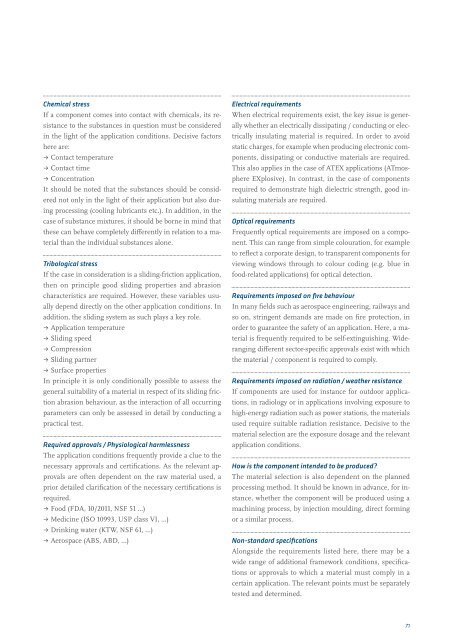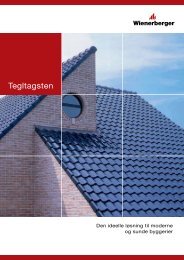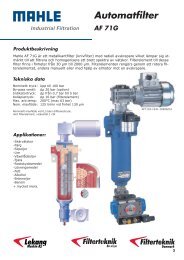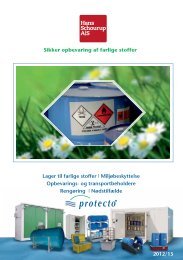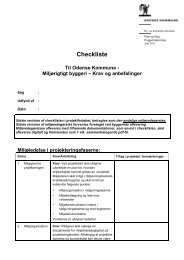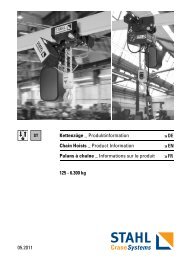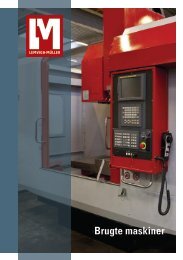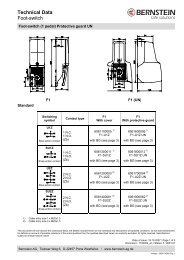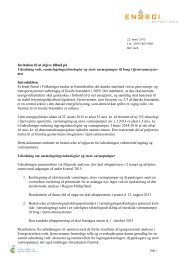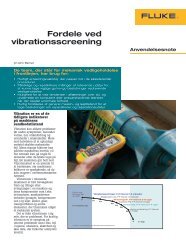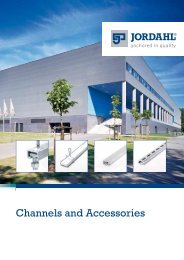Engineering plastics â The Manual - F.wood-supply.dk
Engineering plastics â The Manual - F.wood-supply.dk
Engineering plastics â The Manual - F.wood-supply.dk
Create successful ePaper yourself
Turn your PDF publications into a flip-book with our unique Google optimized e-Paper software.
Chemical stress<br />
If a component comes into contact with chemicals, its resistance<br />
to the substances in question must be considered<br />
in the light of the application conditions. Decisive factors<br />
here are:<br />
ˌˌContact temperature<br />
ˌˌContact time<br />
ˌˌConcentration<br />
It should be noted that the substances should be considered<br />
not only in the light of their application but also during<br />
processing (cooling lubricants etc.). In addition, in the<br />
case of substance mixtures, it should be borne in mind that<br />
these can behave completely differently in relation to a material<br />
than the individual substances alone.<br />
Tribological stress<br />
If the case in consideration is a sliding-friction application,<br />
then on principle good sliding properties and abrasion<br />
characteristics are required. However, these variables usually<br />
depend directly on the other application conditions. In<br />
addition, the sliding system as such plays a key role.<br />
ˌˌApplication temperature<br />
ˌˌSliding speed<br />
ˌˌCompression<br />
ˌˌSliding partner<br />
ˌˌSurface properties<br />
In principle it is only conditionally possible to assess the<br />
general suitability of a material in respect of its sliding friction<br />
abrasion behaviour, as the interaction of all occurring<br />
parameters can only be assessed in detail by conducting a<br />
practical test.<br />
Required approvals / Physiological harmlessness<br />
<strong>The</strong> application conditions frequently provide a clue to the<br />
necessary approvals and certifications. As the relevant approvals<br />
are often dependent on the raw material used, a<br />
prior detailed clarification of the necessary certifications is<br />
required.<br />
ˌˌFood (FDA, 10/2011, NSF 51 …)<br />
ˌˌMedicine (ISO 10993, USP class VI, …)<br />
ˌˌDrinking water (KTW, NSF 61, …)<br />
ˌˌAerospace (ABS, ABD, …)<br />
Electrical requirements<br />
When electrical requirements exist, the key issue is generally<br />
whether an electrically dissipating / conducting or electrically<br />
insulating material is required. In order to avoid<br />
static charges, for example when producing electronic components,<br />
dissipating or conductive materials are required.<br />
This also applies in the case of ATEX applications (ATmosphere<br />
EXplosive). In contrast, in the case of components<br />
required to demonstrate high dielectric strength, good insulating<br />
materials are required.<br />
Optical requirements<br />
Frequently optical requirements are imposed on a component.<br />
This can range from simple colouration, for example<br />
to reflect a corporate design, to transparent components for<br />
viewing windows through to colour coding (e.g. blue in<br />
food-related applications) for optical detection.<br />
Requirements imposed on fire behaviour<br />
In many fields such as aerospace engineering, railways and<br />
so on, stringent demands are made on fire protection, in<br />
order to guarantee the safety of an application. Here, a material<br />
is frequently required to be self-extinguishing. Wideranging<br />
different sector-specific approvals exist with which<br />
the material / component is required to comply.<br />
Requirements imposed on radiation / weather resistance<br />
If components are used for instance for outdoor applications,<br />
in radiology or in applications involving exposure to<br />
high-energy radiation such as power stations, the materials<br />
used require suitable radiation resistance. Decisive to the<br />
material selection are the exposure dosage and the relevant<br />
application conditions.<br />
How is the component intended to be produced?<br />
<strong>The</strong> material selection is also dependent on the planned<br />
processing method. It should be known in advance, for instance,<br />
whether the component will be produced using a<br />
machining process, by injection moulding, direct forming<br />
or a similar process.<br />
Non-standard specifications<br />
Alongside the requirements listed here, there may be a<br />
wide range of additional framework conditions, specifications<br />
or approvals to which a material must comply in a<br />
certain application. <strong>The</strong> relevant points must be separately<br />
tested and determined.<br />
71


